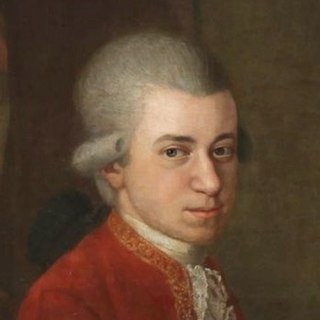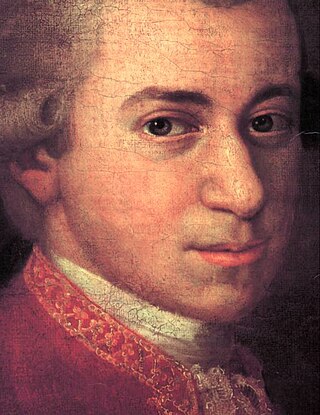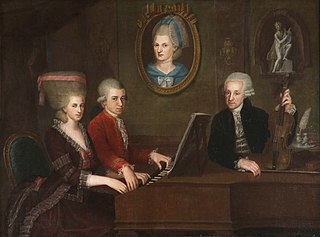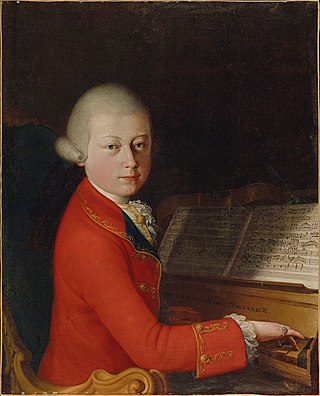
The Symphony No. 36 in C major, K. 425, also known as the Linz Symphony, was written by Wolfgang Amadeus Mozart during a stopover in the Austrian town of Linz on his and his wife's way back home to Vienna from Salzburg in late 1783. The entire symphony was written in four days to accommodate the local count's announcement, upon hearing of the Mozarts' arrival in Linz, of a concert. The première in Linz took place on 4 November 1783. The composition was also premièred in Vienna on 1 April 1784. The autograph score of the "Linz Symphony" was not preserved, but a set of parts sold by Mozart to the Fürstenberg court at Donaueschingen in 1786 does survive.

The piece of music once known as Wolfgang Amadeus Mozart's Symphony No. 2 in B♭ major, K. 17, is now considered to be not by him, but by possibly his father, Leopold Mozart. This symphony has been given the number Anhang C 11.02 in the sixth edition of Ludwig Ritter von Köchel's catalogue of Mozart's music, and is now also catalogued as Eisen B♭ 6 in Cliff Eisen's catalogue of Leopold Mozart's symphonies. It was written for 2 oboes, 2 horns in B♭, and a string section.

The Symphony No. 39 in E♭ major of Wolfgang Amadeus Mozart, K. 543, was completed on 26 June 1788.

Symphony No. 35 in D major, K. 385, also known as the Haffner Symphony, was composed by Wolfgang Amadeus Mozart in 1782. It was commissioned by the Haffners, a prominent Salzburg family, for the occasion of the ennoblement of Sigmund Haffner the Younger. The Haffner Symphony should not be confused with the eight-movement Haffner Serenade, another piece Mozart wrote on commission from the same family in 1776.

Symphony No. 20 in D major, K. 133, was composed by Wolfgang Amadeus Mozart in July, 1772, when Mozart was sixteen years old. This symphony is one of many written during the period Mozart stayed in Salzburg, between two trips to Italy. Compared to other symphonies Mozart wrote in this period, the scoring is extravagant, featuring two trumpets in addition to the standard oboes, horns, and strings. The key of D major, which is a key often reserved for ceremonial music, is well suited to the presence of these trumpets.

The Symphony No. 33 in B♭ major, K. 319, was written by Wolfgang Amadeus Mozart, and dated on 9 July 1779.

Symphony No. 14 in A major, K. 114, is a symphony composed by Wolfgang Amadeus Mozart on December 30, 1771, when Mozart was fifteen years old, and a fortnight after the death of the Archbishop Sigismund von Schrattenbach. The piece was written in Salzburg between the composer's second and third trips to Italy. Mozart was also influenced by J. C. Bach's "Italianate" style of composition".

The Serenade No. 10 for winds in B-flat major, K. 361/370a, is a serenade by Wolfgang Amadeus Mozart scored for thirteen instruments: twelve winds and string bass. The piece was probably composed in 1781 or 1782 and is often known by the subtitle Gran Partita, though the title is a misspelling and not in Mozart's hand. It consists of seven movements.

Wolfgang Amadeus Mozart's String Quartet No. 15 in D minor, K. 421/417b is the second of the Quartets dedicated to Haydn and the only one of the set in a minor key. Though undated in the autograph, it is believed to have been completed in 1783, while his wife Constanze Mozart was in labour with her first child Raimund. Constanze stated that the rising string figures in the second movement corresponded to her cries from the other room.

The Serenade for Orchestra No. 9 in D major K. 320, Posthorn, was written by Wolfgang Amadeus Mozart in Salzburg, in 1779. The manuscript is dated 3 August 1779 and was intended for the University of Salzburg's "Finalmusik" ceremony that year.

Symphony No. 19 in E-flat major, K. 132, is a symphony composed by Wolfgang Amadeus Mozart in July 1772.

Symphony No. 21 in A major, K. 134, is a symphony that was composed by Wolfgang Amadeus Mozart in August 1772.
Wolfgang Amadeus Mozart composed six sonatas for keyboard with accompaniment of violin and cello, K. 10–15, in late 1764 in London during the Mozart family's grand tour of Europe. Queen Charlotte commissioned them on 25 October, and the works were dedicated to her on 18 January 1765. They were published as Mozart's "Opus III" by his father Leopold at 20 Frith Street, Soho, London, where the Mozarts lived from September 1764 until after May 1765.
Wolfgang Amadeus Mozart's set of six sonatas for keyboard and violin, K. 26–31 were composed in early 1766 in The Hague during the Mozart family's grand tour of Europe. They were dedicated to Princess Caroline of Nassau-Weilburg on the occasion of the eighteenth birthday of her brother, William V, Prince of Orange. They were published as Mozart's Opus 4.
The six string quartets, K. 168–173, were composed by Wolfgang Amadeus Mozart in late 1773 in Vienna. These are popularly known as the Viennese Quartets. Mozart may have hoped to have them published at the time, but they were published only posthumously by Johann André in 1801 as Mozart's Op. 94.
The Serenade No. 5 in D major, K. 204/213a was written on 5 August 1775 by Wolfgang Amadeus Mozart for ceremonies at the University of Salzburg. The work is very similar to the serenade K. 203, composed for Salzburg the previous summer.
The Symphony in F major "No. 43", K. 76/42a, was probably written by Wolfgang Amadeus Mozart.
The Divertimento No. 17 in D major, K. 334/320b was composed by Wolfgang Amadeus Mozart between 1779 and 1780 and was possibly composed for commemorating the graduation of a close friend of Mozart's, Georg Sigismund Robinig, from his law studies at the University of Salzburg in 1780. Lasting about 42 minutes, it is the longest of the divertimenti by Mozart.
The divertimenti in F major, B-flat major, E-flat major, F major, and B-flat major are five companion compositions for pairs of oboes, horns and bassoons by Wolfgang Amadeus Mozart.










